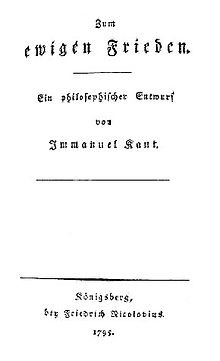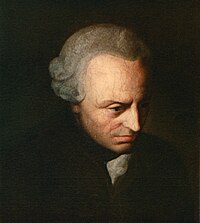
Back السلام الدائم: مخطط فلسفي Arabic Əbədi Sülh: Fəlsəfi Eskiz Azerbaijani Zum ewigen Frieden German Al Eterna Paco Esperanto Sobre la paz perpetua Spanish صلح پایدار: یک طرح فلسفی Persian Ikuiseen rauhaan Finnish Vers la paix perpétuelle French Zum ewigen Frieden Galician לשלום הנצחי HE
You can help expand this article with text translated from the corresponding article in German. Click [show] for important translation instructions.
|
 Cover of the book | |
| Author | Immanuel Kant |
|---|---|
| Original title | Zum ewigen Frieden. Ein philosophischer Entwurf |
| Language | German |
| Subject | Philosophy |
| Set in | Konigsberg |
| Publisher | F. Nicolovius |
Publication date | 1795 |
| Publication place | Germany |
| Pages | 114 |
| Preceded by | Über den Gemeinspruch: Das mag in der Theorie richtig sein, taugt aber nicht für die Praxis (1793) |
| Followed by | Metaphysik der Sitten (1797) |
| Part of a series on |
| Immanuel Kant |
|---|
 |
|
Category • |
| Part of the Politics series |
| Republicanism |
|---|
|
|
Perpetual Peace: A Philosophical Sketch (German: Zum ewigen Frieden. Ein philosophischer Entwurf) is a 1795 book authored by German philosopher Immanuel Kant.[1] In the book, Kant advances ideas that have subsequently been associated with democratic peace, commercial peace, and institutional peace.[2][3][4]
- ^ Kant, Immanuel (1795). Zum ewigen Frieden : ein philosophischer Entwurf (1 ed.). Königsberg: bey Friedrich Nicolovius. doi:10.3931/e-rara-25308.
- ^ Oneal, John R.; Russet, Bruce M. (1997). "The Classical Liberals Were Right: Democracy, Interdependence, and Conflict, 1950-1985". International Studies Quarterly. 41 (2): 267–294. doi:10.1111/1468-2478.00042. ISSN 0020-8833.
- ^ Russett, Bruce; Oneal, John R.; Davis, David R. (1998). "The Third Leg of the Kantian Tripod for Peace: International Organizations and Militarized Disputes, 1950-85". International Organization. 52 (3): 441–467. doi:10.1162/002081898550626. ISSN 0020-8183. JSTOR 2601398.
- ^ Deudney, Daniel H. (2007). Bounding Power: Republican Security Theory from the Polis to the Global Village. Princeton University Press. pp. 10, 155–156. ISBN 978-1-4008-3727-4.
© MMXXIII Rich X Search. We shall prevail. All rights reserved. Rich X Search